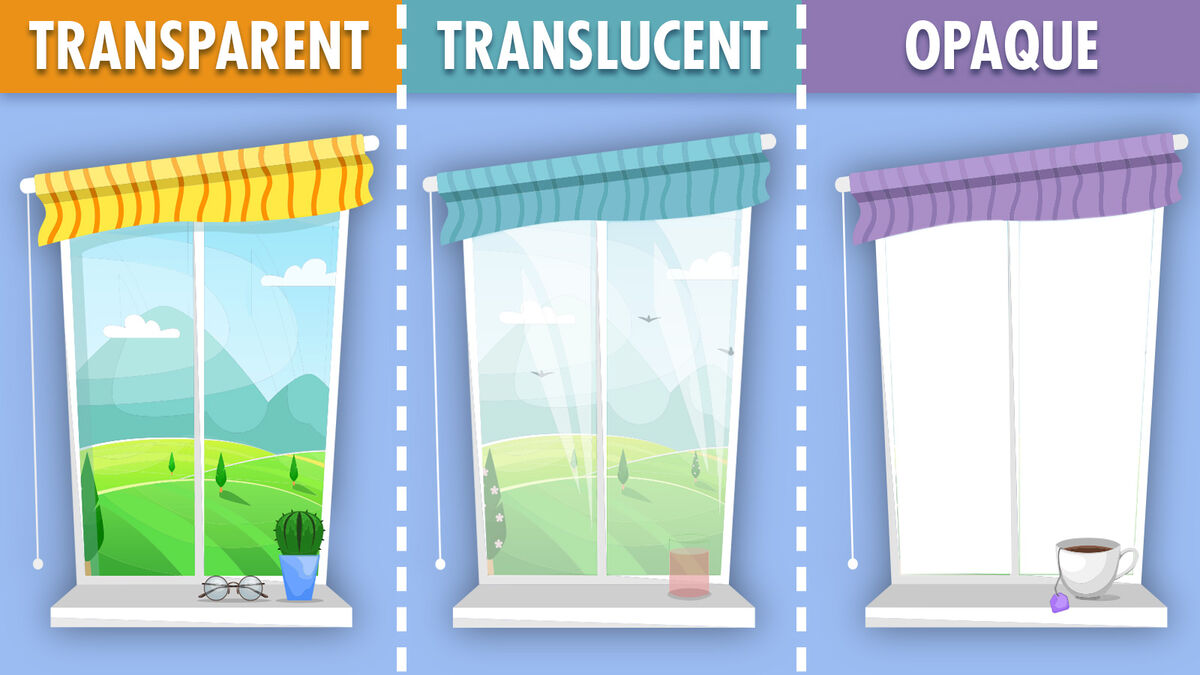
Transparent, translucent, and opaque all describe how certain objects allow visible light to travel through them. While these adjectives seem synonymous to some, they are not. Explore the subtle differences between transparent, translucent and opaque through definitions and examples.
Definition of Transparent
The word transparent is an adjective used to describe “something clear or see-through.” If an object is transparent, you can clearly see things on the other side of it by looking through that object.
Almost all the light that encounters a transparent object will pass directly through that object. You can see details like colors through transparent objects.
Transparent Examples
People use transparent objects every day as tools and as protection.
- clear glass windowpane
- cling wrap
- cellophane
- clear glass lightbulb
- water
- clean air
Definition of Translucent
The word translucent is an adjective used to describe something “allowing light to pass through but not showing the distinct images on the other side.” If an object is translucent, you can see that there is something on the other side of it when looking through it, but you can’t tell exactly what you’re seeing.
Some of the light that encounters a translucent object will pass directly through that object. You see fuzzy, unclear images through translucent objects.
Translucent Examples
Examples of translucent objects also include everyday materials.
- frosted glass shower door
- tinted car window
- sunglasses
- wax paper
- single piece of tissue paper
- vegetable oil
- sauteed onions
Definition of Opaque
The word opaque is an adjective used to describe something “not capable of having light pass through.” In science terms, opaque is actually the opposite of transparent and translucent.
Opaque Examples
Anything you can’t see through at all would be considered an example of an opaque object.
- wooden door
- stone wall
- metal roof
- closed textbook
Translucent vs. Transparent
Now that you know how the term opaque differs from translucent and transparent, it’s time to take a closer look at the latter two terms.
Transparent | Translucent |
almost all light passes through | some light passes through |
light passes directly through | light scatters as it passes through |
details of the other side are visible | details of the other side aren’t visible |
Transparent, Translucent or Opaque Experiment
You can do a simple experiment at home or in the classroom to test whether an object is transparent, translucent, or opaque.
- Gather the objects you want to test.
- Put a detailed, full-color picture in a picture frame and stand it up on a table in a well-lighted room.
- Hold one object up between your eyes and the picture.
- Record what you see of the picture through the object.
- If you can see details of the picture, such as the different colors, it is transparent. If you can see the main shapes of the picture, but not details, it is translucent. If you can’t see the picture at all, it is opaque.
See the Light
It’s easy to get the terms transparent, translucent, and opaque confused. Once you familiarize yourself with the definition for each term, you’ll clearly see how different they are. Continue learning about light by exploring examples of luminescence.